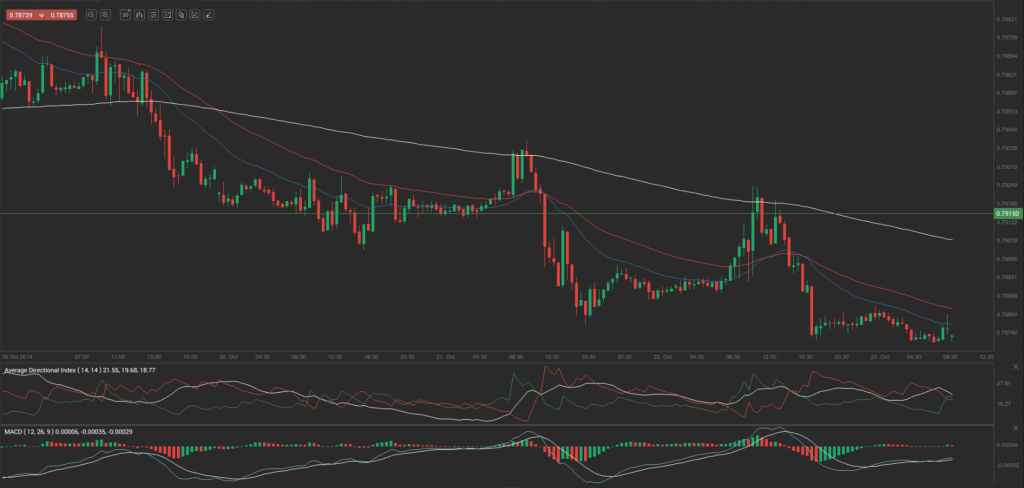Yesterday’s trade saw EUR/GBP within the range of 0.7870-0.7927. The pair closed at 0.7881, losing 0.14% on a daily basis.
At 6:23 GMT today EUR/GBP was down 0.04% for the day to trade at 0.7878. The pair touched a daily low at 0.7872 at 5:40 GMT.
Fundamentals
Euro zone
Manufacturing and Services PMIs – preliminary readings
Frances preliminary manufacturing PMI probably remained in the zone of contraction, coming in at 48.5 in October, acording to the median forecast by experts. The final PMI stood at 48.8 in September, as reported on October 1st. Values below the key level of 50.0 indicate that the majority of respondents in the survey expressed pessimism in regard to activity in the sector. Markit Economics is expected to release the official data at 7:00 GMT.
French preliminary services PMI probably slipped to 48.2 in October from a final reading of 48.4 in the prior month. If so, this would be the lowest index reading since June, after in July and August the indicator stood in the zone of expansion. Markit will publish the preliminary data at 7:00 GMT.
The preliminary reading of German manufacturing PMI probably remained below 50.0 for the second consecutive month in October, sliding to 49.5, from a final reading of 49.9 in September, as reported on October 1st. If so, this would be the lowest index reading since June 2013. The preliminary value is due out at 7:30 GMT.
Activity in German services sector probably slowed down in October, with the preliminary PMI falling to 55.0 from a final reading of 55.7 in September. The preliminary data is to be released at 7:30 GMT.
Manufacturing activity in the whole Euro region probably entered the zone of contraction for the first time since June 2013 in October, with the preliminary Purchasing Managers Index slipping to 49.9 from a final value of 50.3 during the preceding month. The PMI reflects the performance of the manufacturing sector in the area and is based on a survey of 3 000 manufacturing companies. National data are included for Germany, France, Italy, Spain, the Netherlands, Austria, the Republic of Ireland and Greece. These member states together account for almost 90% of Euro zones manufacturing activity. The Manufacturing Purchasing Managers Index is comprised by five individual indexes with the following weights: New Orders (30%), Output (25%), Employment (20%), Suppliers’ Delivery Times (15%) and Stock of Items Purchased (10%), as the Delivery Times index is inverted, so that it moves in a comparable direction. The preliminary data is expected at 8:00 GMT.
The preliminary services PMI in the Euro zone probably also lost ground in October, reaching a level of 52.0. In September the final reading of the index was reported to have been at 52.4. The PMI is based on data collected from a representative panel of around 2 000 private service sector companies. National services data are included for Germany, France, Italy, Spain and the Republic of Ireland. The survey represents private sector conditions in terms of new orders, output, employment, prices etc. Lower than expected PMI readings would certainly mount selling pressure on the common currency. Markit will release the preliminary data at 8:00 GMT.
Spanish unemployment survey
Spains jobless rate probably decreased to 24.30% during the three months to September, according to market expectations, from 24.47% in Q2. The latter has been the lowest rate of unemployment since the second quarter of 2012, as the number of job positions in the sector of services increased at a strong pace. In Q2 the number of unemployed persons decreased to 5.623 million. Employment increased 2.37% during Q2 compared to the previous quarter to reach 17.35 million, or the fastest rate of increase since the second quarter of 2005. Compared to Q2 2013, employment rose for the first time in six years by 1.12% (or by 192 400 persons). In Q2 the services sector added 378.7 thousand new job positions, the industrial sector produced 56.7 thousand jobs, while construction created 36.9 thousand positions, according to data by the National Statistics Institute (INE).
The unemployment rate represents the percentage of the eligible work force that is unemployed, but is actively seeking employment. This rate also reflects overall economic state in the country, as there is a strong correlation between consumer spending levels and labor market conditions. High rates of unemployment are accompanied by weaker spending, which causes an adverse effect on corporate profits and also leads to overall growth deceleration. Therefore, in case the rate of unemployment fell more than expected, this would provide support to the euro. The official jobless rate is due out at 7:00 GMT.
Euro zone consumer confidence
Confidence among consumers in the Euro area probably continued to worsen in October. The preliminary Economic Sentiment Indicator (ESI) probably slid to -12.0 in the current month from a final reading of -11.4 in September, as reported on August 29th. If so, this would be the lowest index reading since February. The ESI reflects the level of optimism, which consumers have about economic development. The survey is conducted by phone and includes 23 000 households in the Euro zone. The questions asked stress on current economic and financial situation, savings intention and also on expected developments regarding consumer price indexes, general economic situation and major purchases of durable goods. The indicator measures consumer confidence on a scale of -100 to +100. A reading of -100 suggests a lack of confidence, zero means neutrality and a reading of +100 indicates extreme levels of confidence. Higher confidence usually implies greater willingness to spend, including large-ticket purchases, while consumer spending is a key factor behind economic growth. Therefore, in case the ESI dropped more than anticipated, this would cause a bearish impact on the euro. The European Commission is expected to release the preliminary reading at 14:00 GMT.
United Kingdom
Retail Sales
Annualized retail sales in the United Kingdom probably rose 2.8% in September, according to the median forecast by experts, after in August sales climbed 3.9%, with the latter being the fastest rate of increase since April. In monthly terms, retail sales probably dropped 0.1% during September, following a 0.4% gain in August. Annualized retail sales, without taking into account fuel sales, probably rose 3.4% in September.
This is a short-term indicator, which provides key information about consumption on a national scale. Higher retail sales suggest stronger consumer demand, confidence and economic growth, respectively. Therefore, in case the index of retail sales increased at a faster than projected pace, this would be pound positive. The Office for National Statistics is expected to publish the official report at 8:30 GMT.
Mortgage Approvals by the BBA
The number of home loans in the United Kingdom, issued by the British Bankers’ Association (BBA), probably was 41 400 in September, following a number of 41 588 in August. The BBA features the major banks in the country, which account for almost 60% of overall mortgage lending. The number of mortgage loans is considered as a leading indicator in regard to UK housing market conditions. As growth in mortgage lending signifies a healthy housing sector, which also contributes to overall economic activity, in case the number of loans came in greater than projected, this would boost demand for the sterling. The BBA is to publish the official figure at 8:30 GMT.
Industrial Orders by the CBI
The gauge of industrial orders in the United Kingdom probably remained unchanged at a reading of -4 during the three months to October, according to expectations. This indicator reflects the net balance between companies, that registered an increase in industrial orders during the respective period of three months and those, that registered a drop. It is the oldest indicator, released from the UK private sector, to show the development tendency in countrys industrial sector. The Industrial Trends Survey by the Confederation of British Industry (CBI) provides expert qualitative opinion from senior manufacturing executives, on past and expected trends in output, exports, prices, costs, investment intentions, business confidence and capacity utilization. A level above zero suggests that volume of orders is projected to increase, while a level below zero indicates that expectations point to lower volumes. If the survey showed predominant pessimism, this would have a bearish effect on the sterling. The CBI will announce the results from its survey, encompassing 17 industries, at 10:00 GMT.
Pivot Points
According to Binary Tribune’s daily analysis, the central pivot point for the pair is at 0.7893. In case EUR/GBP manages to breach the first resistance level at 0.7915, it will probably continue up to test 0.7950. In case the second key resistance is broken, the pair will probably attempt to advance to 0.7972.
If EUR/GBP manages to breach the first key support at 0.7858, it will probably continue to slide and test 0.7836. With this second key support broken, the movement to the downside will probably continue to 0.7801.
The mid-Pivot levels for today are as follows: M1 – 0.7819, M2 – 0.7847, M3 – 0.7876, M4 – 0.7904, M5 – 0.7933, M6 – 0.7961.
In weekly terms, the central pivot point is at 0.7943. The three key resistance levels are as follows: R1 – 0.8035, R2 – 0.8140, R3 – 0.8232. The three key support levels are: S1 – 0.7838, S2 – 0.7746, S3 – 0.7641.






